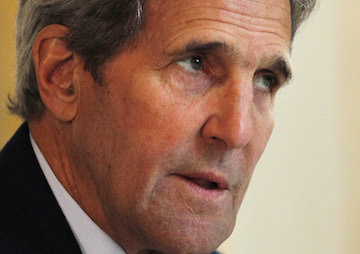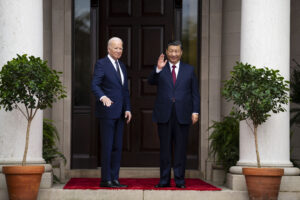Russia or China: Who Should Lead America’s Enemies List?
Lacking consensus about who constitutes the United States’ principal great-power adversary, it has become increasingly difficult for Washington policymakers to forge long-term strategic plans. And yet, there is no reason to assume that the anointment of a common enemy -- a new Soviet Union -- will make this country and the world any safer than it is today.
By Michael T. Klare, TomDispatch

U.S. Secretary of State John Kerry. (Carlos Barria / AP)
This piece first appeared at TomDispatch. Read Nick Turse’s introduction here.
America’s grand strategy, its long-term blueprint for advancing national interests and countering major adversaries, is in total disarray. Top officials lurch from crisis to crisis, improvising strategies as they go, but rarely pursuing a consistent set of policies. Some blame this indecisiveness on a lack of resolve at the White House, but the real reason lies deeper. It lurks in a disagreement among foreign policy elites over whether Russia or China constitutes America’s principal great-power adversary.
Knowing one’s enemy is usually considered the essence of strategic planning. During the Cold War, enemy number one was, of course, unquestioned: it was the Soviet Union, and everything Washington did was aimed at diminishing Moscow’s reach and power. When the USSR imploded and disappeared, all that was left to challenge U.S. dominance were a few “rogue states.” In the wake of 9/11, however, President Bush declared a “global war on terror,” envisioning a decades-long campaign against Islamic extremists and their allies everywhere on the planet. From then on, with every country said to be either with us or against us, the chaos set in. Invasions, occupations, raids, drone wars ensued — all of it, in the end, disastrous — while China used its economic clout to gain new influence abroad and Russia began to menace its neighbors.
Among Obama administration policymakers and their Republican opponents, the disarray in strategic thinking is striking. There is general agreement on the need to crush the Islamic State (ISIS), deny Iran the bomb, and give Israel all the weapons it wants, but not much else. There is certainly no agreement on how to allocate America’s strategic resources, including its military ones, even in relation to ISIS and Iran. Most crucially, there is no agreement on the question of whether a resurgent Russia or an ever more self-assured China should head Washington’s enemies list. Lacking such a consensus, it has become increasingly difficult to forge long-term strategic plans. And yet, while it is easy to decry the current lack of consensus on this point, there is no reason to assume that the anointment of a common enemy — a new Soviet Union — will make this country and the world any safer than it is today.
Choosing the Enemy
For some Washington strategists, including many prominent Republicans, Russia under the helm of Vladimir Putin represents the single most potent threat to America’s global interests, and so deserves the focus of U.S. attention. “Who can doubt that Russia will do what it pleases if its aggression goes unanswered?” Jeb Bush asserted on June 9th in Berlin during his first trip abroad as a potential presidential contender. In countering Putin, he noted, “our alliance [NATO], our solidarity, and our actions are essential if we want to preserve the fundamental principles of our international order, an order that free nations have sacrificed so much to build.”
For many in the Obama administration, however, it is not Russia but China that poses the greatest threat to American interests. They feel that its containment should take priority over other considerations. If the U.S. fails to enact a new trade pact with its Pacific allies, Obama declared in April, “China, the 800-pound gorilla in Asia, will create its own set of rules,” further enriching Chinese companies and reducing U.S. access “in the fastest-growing, most dynamic economic part of the world.”
In the wake of the collapse of the Soviet Union, the military strategists of a seemingly all-powerful United States — the unchallenged “hyperpower” of the immediate post-Cold War era — imagined the country being capable of fighting full-scale conflicts on two (or even three fronts) at once. The shock of the twenty-first century in Washington has been the discovery that the U.S. is not all-powerful and that it can’t successfully take on two major adversaries simultaneously (if it ever could). It can, of course, take relatively modest steps to parry the initiatives of both Moscow and Beijing while also fighting ISIS and other localized threats, as the Obama administration is indeed attempting to do. However, it cannot also pursue a consistent, long-range strategy aimed at neutralizing a major adversary as in the Cold War. Hence a decision to focus on either Russia or China as enemy number one would have significant implications for U.S. policy and the general tenor of world affairs.
Choosing Russia as the primary enemy, for example, would inevitably result in a further buildup of NATO forces in Eastern Europe and the delivery of major weapons systems to Ukraine. The Obama administration has consistently opposed such deliveries, claiming that they would only inflame the ongoing conflict and sabotage peace talks. For those who view Russia as the greatest threat, however, such reluctance only encourages Putin to escalate his Ukrainian intervention and poses a long-term threat to U.S. interests. In light of Putin’s ruthlessness, said Senator John McCain, chairman of the Senate Armed Services Committee and a major advocate of a Russia-centric posture, the president’s unwillingness to better arm the Ukrainians “is one of the most shameful and dishonorable acts I have seen in my life.”
On the other hand, choosing China as America’s principal adversary means a relatively restrained stance on the Ukrainian front coupled with a more vigorous response to Chinese claims and base building in the South China Sea. This was the message delivered to Chinese leaders by Secretary of Defense Ashton Carter in late May at U.S. Pacific Command headquarters in Honolulu. Claiming that Chinese efforts to establish bases in the South China Sea were “out of step” with international norms, he warned of military action in response to any Chinese efforts to impede U.S. operations in the region. “There should be… no mistake about this — the United States will fly, sail, and operate wherever international law allows.”
If you happen to be a Republican (other than Rand Paul) running for president, it’s easy enough to pursue an all-of-the-above strategy, calling for full-throttle campaigns against China, Russia, Iran, Syria, ISIS, and any other adversary that comes to mind. This, however, is rhetoric, not strategy. Eventually, one or another approach is likely to emerge as the winner and the course of history will be set.
The “Pivot” to Asia
The Obama administration’s fixation on the “800-pound gorilla” that is China came into focus sometime in 2010-2011. Plans were then being made for what was assumed to be the final withdrawal of U.S. forces from Iraq and the winding down of the American military presence in Afghanistan. At the time, the administration’s top officials conducted a systematic review of America’s long-term strategic interests and came to a consensus that could be summed up in three points: Asia and the Pacific Ocean had become the key global theater of international competition; China had taken advantage of a U.S. preoccupation with Iraq and Afghanistan to bolster its presence there; and to remain the world’s number one power, the United States would have to prevent China from gaining more ground.
This posture, spelled out in a series of statements by President Obama, Secretary of State Hillary Clinton, and other top administration officials, was initially called the “pivot to Asia” and has since been relabeled a “rebalancing” to that region. Laying out the new strategy in 2011, Clinton noted, “The Asia-Pacific has become a key driver of global politics. Stretching from the Indian subcontinent to the western shores of the Americas… it boasts almost half of the world’s population [and] includes many of the key engines of the global economy.” As the U.S. withdrew from its wars in the Middle East, “one of the most important tasks of American statecraft over the next decade will therefore be to lock in substantially increased investment — diplomatic, economic, strategic, and otherwise — in the Asia-Pacific region.”
This strategy, administration officials claimed then and still insist, was never specifically aimed at containing the rise of China, but that, of course, was a diplomatic fig leaf on what was meant to be a full-scale challenge to a rising power. It was obvious that any strengthened American presence in the Pacific would indeed pose a direct challenge to Beijing’s regional aspirations. “My guidance is clear,” Obama told the Australian parliament that same November. “As we plan and budget for the future, we will allocate the resources necessary to maintain our strong military presence in this region. We will preserve our unique ability to project power and deter threats to peace.”
Implementation of the pivot, Obama and Clinton explained, would include support for or cooperation with a set of countries that ring China, including increased military aid to Japan and the Philippines, diplomatic outreach to Burma, Indonesia, Malaysia, Vietnam, and other nations in Beijing’s economic orbit, military overtures to India, and the conclusion of a major trade arrangement, the Trans-Pacific Partnership (TPP), that would conveniently include most countries in the region but exclude China.
Many in Washington have commented on how much more limited the administration’s actions in the Pacific have proven to be than the initial publicity suggested. Of course, Washington soon found itself re-embroiled in the Greater Middle East and shuttling many of its military resources back into that region, leaving less than expected available for a rebalancing to Asia. Still, the White House continues to pursue a strategic blueprint aimed at bolstering America’s encirclement of China. “No matter how many hotspots emerge elsewhere, we will continue to deepen our enduring commitment to this critical region,” National Security Adviser Susan Rice declared in November 2013.
For Obama and his top officials, despite the challenge of ISIS and of disintegrating states like Yemen and Libya wracked with extremist violence, China remains the sole adversary capable of taking over as the world’s top power. (Its economy already officially has.) To them, this translates into a simple message: China must be restrained through all means available. This does not mean, they claim, ignoring Russia and other potential foes. The White House has, for example, signaled that it will begin storing heavy weaponry, including tanks, in Eastern Europe for future use by any U.S. troops rotated into the region to counter Russian pressure against countries that were once part of the Soviet Union. And, of course, the Obama administration is continuing to up the ante against ISIS, most recently dispatching yet more U.S. military advisers to Iraq. They insist, however, that none of these concerns will deflect the administration from the primary task of containing China.
Countering the Resurgent Russian Bear
Not everyone in Washington shares this China-centric outlook. While most policymakers agree that China poses a potential long-term challenge to U.S. interests, an oppositional crew of them sees that threat as neither acute nor immediate. After all, China remains America’s second-leading trading partner (after Canada) and its largest supplier of imported goods. Many U.S. companies do extensive business in China, and so favor a cooperative relationship. Though the leadership in Beijing is clearly trying to secure what it sees as its interests in Asian waters, its focus remains primarily economic and its leaders seek to maintain friendly relations with the U.S., while regularly engaging in high-level diplomatic exchanges. Its president, Xi Jinping, is expected to visit Washington in September.
Vladimir Putin’s Russia, on the other hand, looks far more threatening to many U.S. strategists. Its annexation of Crimea and its ongoing support for separatist forces in eastern Ukraine are viewed as direct and visceral threats on the Eurasian mainland to what they see as a U.S.-dominated world order. President Putin, moreover, has made no secret of his contempt for the West and his determination to pursue Russian national interests wherever they might lead. For many who remember the Cold War era — and that includes most senior U.S. policymakers — this looks a lot like the menacing behavior of the former Soviet Union; for them, Russia appears to be posing an existential threat to the U.S. in a way that China does not.
Among those who are most representative of this dark, eerily familiar, and retrograde outlook is Senator McCain. Recently, offering an overview of the threats facing America and the West, he put Russia at the top of the list:
“In the heart of Europe, we see Russia emboldened by a significant modernization of its military, resurrecting old imperial ambitions, and intent on conquest once again. For the first time in seven decades on this continent, a sovereign nation has been invaded and its territory annexed by force. Worse still, from central Europe to the Caucuses, people sense Russia’s shadow looming larger, and in the darkness, liberal values, democratic sovereignty, and open economies are being undermined.”
For McCain and others who share his approach, there is no question about how the U.S. should respond: by bolstering NATO, providing major weapons systems to the Ukrainians, and countering Putin in every conceivable venue. In addition, like many Republicans, McCain favors increased production via hydro-fracking of domestic shale gas for export as liquefied natural gas to reduce the European Union’s reliance on Russian gas supplies.
McCain’s views are shared by many of the Republican candidates for president. Jeb Bush, for instance, described Putin as “a ruthless pragmatist who will push until someone pushes back.” Senator Ted Cruz, when asked on Fox News what he would do to counter Putin, typically replied, “One, we need vigorous sanctions… Two, we should immediately reinstate the antiballistic missile batteries in Eastern Europe that President Obama canceled in 2009 in an effort to appease Russia. And three, we need to open up the export of liquid natural gas, which will help liberate Ukraine and Eastern Europe.” Similar comments from other candidates and potential candidates are commonplace.
As the 2016 election season looms, expect the anti-Russian rhetoric to heat up. Many of the Republican candidates are likely to attack Hillary Clinton, the presumed Democratic candidate, for her role in the Obama administration’s 2009 “reset” of ties with Moscow, an attempted warming of relations that is now largely considered a failure. “She’s the one that literally brought the reset button to the Kremlin,” said former Texas Governor Rick Perry in April.
If any of the Republican candidates other than Paul prevails in 2016, anti-Russianism is likely to become the centerpiece of foreign policy with far-reaching consequences. “No leader abroad draws more Republican criticism than Putin does,” a conservative website noted in June. “The candidates’ message is clear: If any of them are elected president, U.S. relations with Russia will turn even more negative.”
The Long View
Whoever wins in 2016, what Yale historian Paul Kennedy has termed “imperial overstretch” will surely continue to be an overwhelming reality for Washington. Nonetheless, count on a greater focus of attention and resources on one of those two contenders for the top place on Washington’s enemies list. A Democratic victory spearheaded by Hillary Clinton is likely to result in a more effectively focused emphasis on China as the country’s greatest long-term threat, while a Republican victory would undoubtedly sanctify Russia as enemy number one.
For those of us residing outside Washington, this choice may appear to have few immediate consequences. The defense budget will rise in either case; troops will, as now, be shuttled desperately around the hot spots of the planet, and so on. Over the long run, however, don’t think for a second that the choice won’t matter.
A stepped-up drive to counter Russia will inevitably produce a grim, unpredictable Cold War-like atmosphere of suspicion, muscle-flexing, and periodic crises. More U.S. troops will be deployed to Europe; American nuclear weapons may return there; and saber rattling, nuclear or otherwise, will increase. (Note that Moscow recently announced a decision to add another 40 intercontinental ballistic missiles to its already impressive nuclear arsenal and recall Senator Cruz’s proposal for deploying U.S. anti-missile batteries in Eastern Europe.) For those of us who can remember the actual Cold War, this is hardly an appealing prospect.
A renewed focus on China would undoubtedly prove no less unnerving. It would involve the deployment of additional U.S. naval and air forces to the Pacific and an attendant risk of armed confrontation over China’s expanded military presence in the East and South China Seas. Cooperation on trade and the climate would be imperiled, along with the health of the global economy, while the flow of ideas and people between East and West would be further constricted. (In a sign of the times, China recently announced new curbs on the operations of foreign nongovernmental organizations.) Although that country possesses far fewer nuclear weapons than Russia, it is modernizing its arsenal and the risk of nuclear confrontation would undoubtedly increase as well.
In short, the options for American global policy, post-2016, might be characterized as either grim and chaotic or even grimmer, if more focused. Most of us will fare equally badly under either of those outcomes, though defense contractors and others in what President Dwight Eisenhower first dubbed the “military-industrial complex” will have a field day. Domestic needs like health, education, infrastructure, and the environment will suffer either way, while prospects for peace and climate stability will recede.
A country without a coherent plan for advancing its national interests is a sorry thing. Worse yet, however, as we may find out in the years to come, would be a country forever on the brink of crisis and conflict with a beleaguered, nuclear-armed rival.
Michael T. Klare, a TomDispatch regular, is a professor of peace and world security studies at Hampshire College and the author, most recently, of The Race for What’s Left. A documentary movie version of his book Blood and Oil is available from the Media Education Foundation. Follow him on Twitter at @mklare1.
Follow TomDispatch on Twitter and join us on Facebook. Check out the newest Dispatch Book, Nick Turse’s Tomorrow’s Battlefield: U.S. Proxy Wars and Secret Ops in Africa, and Tom Engelhardt’s latest book, Shadow Government: Surveillance, Secret Wars, and a Global Security State in a Single-Superpower World.
Copyright 2015 Michael T. Klare
Your support matters…Independent journalism is under threat and overshadowed by heavily funded mainstream media.
You can help level the playing field. Become a member.
Your tax-deductible contribution keeps us digging beneath the headlines to give you thought-provoking, investigative reporting and analysis that unearths what's really happening- without compromise.
Give today to support our courageous, independent journalists.






You need to be a supporter to comment.
There are currently no responses to this article.
Be the first to respond.